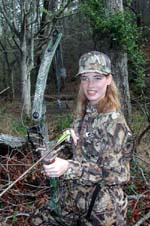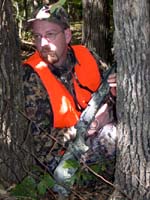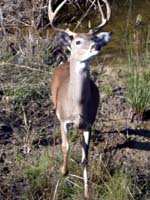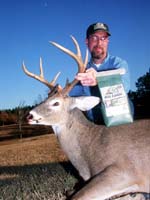HOW TO FIND AND TAKE TROPHY BUCKS IN THE EARLY SEASON
WITH DR. GRANT WOODS
You Still Can't See Them
 Editor's
Note: Dr. Grant Woods of Reeds Spring, Missouri, one
of the nation's leading white-tailed deer researchers,
not only has studied whitetails for many years but also
uses the latest scientific technology to track deer
movement and learn why deer do what they do. We've asked
Woods to tell our readers how to find the bucks of their
dreams this year. Editor's
Note: Dr. Grant Woods of Reeds Spring, Missouri, one
of the nation's leading white-tailed deer researchers,
not only has studied whitetails for many years but also
uses the latest scientific technology to track deer
movement and learn why deer do what they do. We've asked
Woods to tell our readers how to find the bucks of their
dreams this year.
I'm totally convinced that most hunters don't see deer
on the properties they hunt. I was really made aware
of this fact about a decade ago when I was doing a browse
survey on an 80-acre high-fence property in New York
State. Snow was on the ground, and I learned the best
way for me to get around that property was on cross-country
skis. I told myself, "I should have a great opportunity
to see a lot of deer, because I know lots of deer live
on this 800 acres. There's snow on the ground, I know
the deer are hungry, I know they'll be moving, and I
know I'll be quiet as a church mouse on these cross-country
skis. I should be able to slip up on them and see them
before they spot me." Too, a cold front was moving
in that day that created perfect conditions for seeing
deer. However, I stayed on those skis all day long,
and I only saw one deer. Later I learned that more than
200 deer were inside that fence. However, I was doing
my survey right after the land had been intensively
hunted. Those deer had become so accustomed to dodging
hunters that they could hear, see, smell and get out
of my way before I ever could spot them.
I told myself, "I should have a great opportunity
to see a lot of deer, because I know lots of deer live
on this 800 acres. There's snow on the ground, I know
the deer are hungry, I know they'll be moving, and I
know I'll be quiet as a church mouse on these cross-country
skis. I should be able to slip up on them and see them
before they spot me." Too, a cold front was moving
in that day that created perfect conditions for seeing
deer. However, I stayed on those skis all day long,
and I only saw one deer. Later I learned that more than
200 deer were inside that fence. However, I was doing
my survey right after the land had been intensively
hunted. Those deer had become so accustomed to dodging
hunters that they could hear, see, smell and get out
of my way before I ever could spot them.
One of the things happening now is that hunter numbers
are staying relatively stable to decreasing slightly. But the amount
of land to be available to hunt is dramatically decreasing.
Therefore there are more hunters per acre now than ever
before. Yet another factor is that hunters are much
more educated about where, when and how to find deer
than in years past. The deer must be much smarter and
more elusive to survive now than they once did. Deer
have learned that their best defense against hunters
is to fill their bellies with food at night and spend
their daylight hours in thick cover chewing their cuds.
Deer are so adaptable that they quickly learn when danger
is present and when it's not. For instance at Cades
Cove in Tennessee, you'll often see deer moving there
during daylight hours. No one hunts these deer. They
have little or no fear of humans. However, because bears
and other predators move at night, they spend most of
the time bedded-down at night.
relatively stable to decreasing slightly. But the amount
of land to be available to hunt is dramatically decreasing.
Therefore there are more hunters per acre now than ever
before. Yet another factor is that hunters are much
more educated about where, when and how to find deer
than in years past. The deer must be much smarter and
more elusive to survive now than they once did. Deer
have learned that their best defense against hunters
is to fill their bellies with food at night and spend
their daylight hours in thick cover chewing their cuds.
Deer are so adaptable that they quickly learn when danger
is present and when it's not. For instance at Cades
Cove in Tennessee, you'll often see deer moving there
during daylight hours. No one hunts these deer. They
have little or no fear of humans. However, because bears
and other predators move at night, they spend most of
the time bedded-down at night.  Another
phenomenon I've seen in Texas is on the Mexican border.
The deer, and especially the bucks there, move an awful
lot during daylight hours. For a long time, I couldn't
decide why. However, some places along the Mexican border
have so many illegal aliens coming across the border
at night, and so many Border Patrol officers looking
for illegal aliens at night that the land is crawling
with people at night. But in the daylight hours, hardly
anyone is moving where the deer are. So the deer there
have learned to move during daylight hours because they're
less likely to run into people due to the heat. I've
never seen daytime deer movement as much anywhere in
the country as I have along the Mexican border in south
Texas. Another
phenomenon I've seen in Texas is on the Mexican border.
The deer, and especially the bucks there, move an awful
lot during daylight hours. For a long time, I couldn't
decide why. However, some places along the Mexican border
have so many illegal aliens coming across the border
at night, and so many Border Patrol officers looking
for illegal aliens at night that the land is crawling
with people at night. But in the daylight hours, hardly
anyone is moving where the deer are. So the deer there
have learned to move during daylight hours because they're
less likely to run into people due to the heat. I've
never seen daytime deer movement as much anywhere in
the country as I have along the Mexican border in south
Texas.
To learn more about Dr. Grant Woods and Woods and Associates,
you can go to www.deermanagement.net.
|
